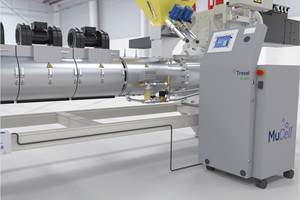Conair Launches New Viper Granulator Product Line
Seven different models are on display at the show, in configurations for injection molding, blow molding and both pipe/profile and film/sheet extrusion.
NPE2018 kicked off Sunday afternoon when Conair officially launched its entirely new portfolio of Viper granulators with standard features that include improved sound insulation, hardened and water-cooled cutting chambers on most models, as well as bigger screens for increased throughput compared to the company’s previous offerings. Seven different models are on display at the show, in configurations for injection molding, blow molding and both pipe/profile and film/sheet extrusion. Conair is exhibiting in Booths W1845, W2163 and S14045.
From small press-side units to large, central granulators, the new Viper product line includes 14 different models with rotor diameters of 6, 8, 12, 17 and 23 inches (140, 200, 300, 420 and 570 mm), and maximum throughputs from 80 lb/hr (36 kg/hr) to 3800 lb/hr (1724 kg/hr). Tangential-feed cutting chambers are standard on smaller grinders, while large units come in a super-tangential configuration to facilitate feeding of large and bulky scrap. Three-blade open rotors are also standard, and other rotor designs are available. Larger granulators and specialty units will be added to the line in the near future.
“The design of our new Viper granulators has been totally customer-driven,” says Sam Rajkovich, vice president of sales & marketing. “Our objective was to develop a straightforward, uncomplicated suite of Conair-designed machines, suitable for most applications. We also wanted to make standard as many popular features as possible. I think we have done just that and very successfully. This may well be the largest product launch at NPE2018 and it certainly is one of the most exciting.”
Every one of the new Viper granulators can be configured for the safe and convenient feeding of scrap in a wide range of shapes and sizes. For basic hand feeding, an upturned feed tray accepts most parts and/or runners. A similar feed-tray configuration suits robot feeding and the front-facing hopper opening accepts metered feeding of scrap via conveyor. Conveyor speed can be automatically regulated to prevent excessive loads on the granulator drive motor. For reclaiming film scrap, the granulator infeed can be fitted with feed rollers (slaved to drive motor amps) that draw film from large rolls. A relief head can be mounted on top to receive blown-in edge trim. When small parts, blow-molding tops and tails, or preshredded scrap is fed by a blower, a cyclone can be fitted to the top of the hopper. And, for long pipes and profiles, an angled side feed chute is used. For other unusual applications, custom infeed configurations can be engineered.
Several evacuation options are also available, including self-powered vacuum motor loaders that draw granulate out of the catch bin and deposit into a Gaylord or bin.
“What we found was that through our knowledge of size reduction, there was a tremendous opportunity to step up our game in size reduction and to increase the quality that can be offered to the marketplace in terms of product breadth,” Rajkovich says. “So we have some unique sizes that haven’t been offered to the market and there are some unique features that haven’t been offered to the market, in terms of hardening, in terms of water cooling, in terms of access to the cutting chambers. So there’s some really unique things we’re doing that are new offerings from Conair and basically we took what we knew about size reduction and we’re offering that to the market.”
Related Content
Sirmax Adapts Integrated Recycling Approach to US Supply Conditions
Integrating compounding and recycling to leverage untapped postindustrial recycling feedstocks.
Read MoreFoam-Core Multilayer Blow Molding: How It’s Done
Learn here how to take advantage of new lightweighting and recycle utilization opportunities in consumer packaging, thanks to a collaboration of leaders in microcellular foaming and multilayer head design.
Read MoreInside the Florida Recycler Taking on NPE’s 100% Scrap Reuse Goal
Hundreds of tons of demonstration products will be created this week. Commercial Plastics Recycling is striving to recycle ALL of it.
Read MoreOptical Sorting for Color Flexibility in Recycled Plastics
Aaron Industries added optical sorting to its operation, expanding capabilities to meet the color needs of customers.
Read MoreRead Next
Making the Circular Economy a Reality
Driven by brand owner demands and new worldwide legislation, the entire supply chain is working toward the shift to circularity, with some evidence the circular economy has already begun.
Read MoreFor PLASTICS' CEO Seaholm, NPE to Shine Light on Sustainability Successes
With advocacy, communication and sustainability as three main pillars, Seaholm leads a trade association to NPE that ‘is more active today than we have ever been.’
Read More









